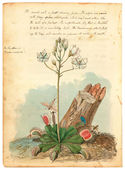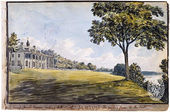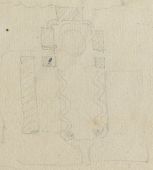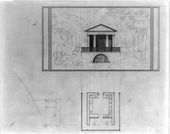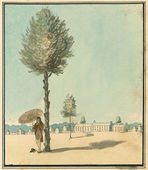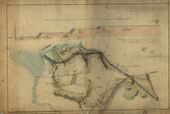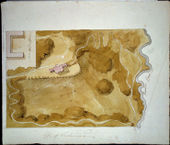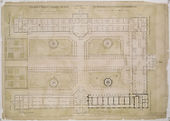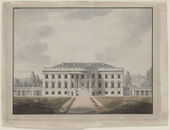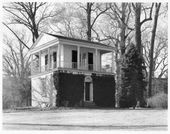Difference between revisions of "Benjamin Henry Latrobe"
Emily Pugh (talk | contribs) |
Emily Pugh (talk | contribs) |
||
| Line 56: | Line 56: | ||
| − | * [[Latrobe, Benjamin Henry]], 1806, describing a sculpture created for the Navy Yard, Washington, D.C. (quoted in Lounsbury 1994: 158)<ref name="Lounsbury_1994"> Lounsbury, Carl R., ed. 1994. An Illustrated Glossary of Early Southern Architecture and Landscape. New York: Oxford University Press. [https://www.zotero.org/groups/54737/items/itemKey/UK5TCUQQ/q/Lounsbury view on Zotero]</ref> | + | * [[Latrobe, Benjamin Henry]], 1806, describing a sculpture created for the Navy Yard, Washington, D.C. (quoted in Lounsbury 1994: 158)<ref name="Lounsbury_1994"> Lounsbury, Carl R., ed. 1994. ''An Illustrated Glossary of Early Southern Architecture and Landscape''. New York: Oxford University Press. [https://www.zotero.org/groups/54737/items/itemKey/UK5TCUQQ/q/Lounsbury view on Zotero]</ref> |
:“[Italian sculptor Franzoni is] now engaged in a Free Eagle, also Colossal for the [[Gate]] of the Navy Yard.” | :“[Italian sculptor Franzoni is] now engaged in a Free Eagle, also Colossal for the [[Gate]] of the Navy Yard.” | ||
Revision as of 21:20, October 10, 2012
Benjamin Henry Boneval Latrobe (May 1, 1764 – September 3, 1820) was a British-born American neoclassical architect best known for his design of the United States Capitol, along with his work on the Baltimore Basilica, the first Roman Catholic Cathedral in the United States. Latrobe was one of the first formally-trained, professional architects in the United States, drawing influences from his travels in Italy, as well as British and French Neoclassical architects such as Claude Nicolas Ledoux.
Sites
Harper's Estate, Oakland, Place D'Armes (renamed Jackson Square), Sedgeley, United States Capitol, United States Navy Hospital and Asylum
Terms
Ancient style, Basin, Canal, Clump, Column/Pillar, Flower Garden, French style, Gate/Gateway, Grove, Ha-Ha/Sunk fence, Landscape Gardening, Lawn, Mall, Obelisk, Parterre, Piazza/Veranda/Porch/Portico, Picturesque, Pleasure ground/Pleasure garden, Quarter, Square, Statue, Temple, Wood/Woods
Texts
Carter II, Edward C., John C. Van Horne, and Charles E. Brownell. Latrobe’s View of America, 1795-1820: Selections from the Watercolors and Sketches. New Haven and London: Yale University Press for the Maryland Historical Society, 1985. view on Zotero
Hamlin, Talbot. Benjamin Henry Latrobe. New York: Oxford University Press, 1955. view on Zotero
Latrobe, Benjamin Henry. Impressions Respecting New Orleans: Diaries and Sketches, 1818-1820. Edited by Samuel Wilson. New York: Columbia University Press, 1951. view on Zotero
———. The Journals of Benjamin Henry Latrobe, 1799-1820: From Philadelphia to New Orleans. Edited by Edward C. Carter II, John C. Van Horne, and Lee W. Formwalt. New Haven, Conn.: Yale University Press, 1980. view on Zotero
———. The Virginia Journals of Benjamin Henry Latrobe, 1795-1798. Edited by Edward C. Carter II. 2 vols. New Haven, Conn.: Yale University Press, 1977. view on Zotero
Citations
- Latrobe, Benjamin Henry, 19 July 1796, describing Mount Vernon, plantation of George Washington, Fairfax County, Va. (1977: 1:163)[1]
- “The general plan of the building is as at Mr. Man Pages at Mansfield near Fredericsburg, of the old School. . . . The center is an old house to which a good dining room has been added at the North end, and a study &c. &c., at the South. The House is connected with the Kitchen offices by arcades.”
- Latrobe, Benjamin Henry, 28 November 1798, describing a prison in Richmond, Va. (CWF)
- “The Ground floor contains the Kitchen and Bakehouse and an open Arcade, the use of which is to admit air into the Area of the building from the Westward, the Quarter from which the Summer winds most usually blow.”
- Latrobe, Benjamin Henry, 17 March 1807, in a letter to Thomas Jefferson, describing the White House, Washington, D.C. (Colonial Williamsburg Foundation)
- “My idea is to carry the road below the hill under a Wall about 8 feet high opposite to the center of the president’s house. At this point, I should propose, at a future day to throw an Arch, or Arches over the road in order to procure a private communication between the pleasure ground of the president’s house and the park which reaches to the river, and which will probably be also planted, and perhaps be open to the public.”
- Latrobe, Benjamin Henry, 26 March 1805, describing a design for a house in Philadelphia, Pa. (CWF)
- “From the kitchen a door leads to the Back stairs, which communicate immediately with the Dining room, and the Lady’s apartment above stairs. At the foot of these stairs is a small room, which can be well adapted to the purpose of a bath, or a store room.”
- Latrobe, Benjamin Henry, 17 March 1807, describing the White House, Washington, D.C. (Colonial Williamsburg Foundation)
- “In removing the ground, it would certainly be necessary to go down in front of the colonnade to the level of about one foot below the bases of the Columns but, it will certainly not deprive this colonnade of any part of its beauty to pass behind a few gentle Knolls and groves or Clumps in its front, and much expense of removing earth would be thereby saved.”
- Latrobe, Benjamin Henry, 14 June 1796, describing Horsdumonde, house of Col. Henry Skipwith, Cumberland County, Va. (quoted in Carter, Van Horne, and Brownell 1985: 80–81)[2]
- “In other respects there is a great deal of worldly beauty and convenience about it. The house is a strange building, but whoever contrived it, and from whatever planet he came he was not a Lunatic, for there is much comfort and room in it, though put together very oddly. Before the South front is a range of hills wooded very much in the Stile of an English park. To the East runs the Apomatox to which a lawn extends.” [Fig. 2]
- Latrobe, Benjamin Henry, 19 July 1796, describing Mount Vernon, plantation of George Washington, Fairfax County, Va. (1977: 1:165)[1]
- “The ground on the West front of the house is laid out in a level lawn bounded on each side with a wide but extremely formal serpentine walk, shaded by weeping Willows. . . . On one side of this lawn is a plain Kitchen garden, on the other a neat flower garden laid out in squares, and boxed with great precission. Along the North Wall of this Garden is a plain Greenhouse. The Plants were arranged in front, and contained nothing very rare, nor were they numerous. For the first time again since I left Germany, I saw here a parterre, chipped and trimmed with infinite care into the form of a richly flourished Fleur de Lis: The expiring groans I hope of our Grandfather’s pedantry.”
- Latrobe, Benjamin Henry, 20 February 1819, describing Montgomery House, New Orleans, La. (1951: 43–45)[3]
- “Close to the river, & separated only by the levee & road, is the old fashioned, but otherwise handsome, garden & house of Mr. Montgomery. The garden, which I think covers not less than 4 acres, is laid out in square walks & flower beds in the old French style. It is entirely enclosed by a thick hedge of orange trees, which have been suf- fered to run up to 15 or 16 feet high on the flanks & rear, but which are shorn down to the highth [sic] of 4 or 5 feet along the road. The Walks are bordered by very large myrtles cut into the shape of large hay cocks, about 8 feet high & as much in diameter. There are so many of them, and they are so exactly equal in size & form that the effect is curious if not elegant. The house itself is one of the usual French plantation houses of the first class &, I think, by far the best kind of house for the climate, namely, a mansion surrounded entirely by a portico or gallery of two stories. The roof is enormous, however. . . . In order to build the redoubt the corner of the garden was cut off, and part of the orange hedge still grows, in a very decayed state, within the line of the redoubt . . . Mr. Montgomery intends restoring his garden to its former state, when the ruins of this work will entirely disappear.” [Fig. 6]
- Latrobe, Benjamin Henry, 28 November 1798, describing a prison at Richmond, Va. (Colonial Williamsburg Foundation)
- “The front Walls were built as high as the Ground line, and considerable progress had been made in erecting the Gate. . . . The Gateway is carried up to its utmost highth, and will be perfectly finished during the winter. It contains two lodges for a porter and Guards, and on each Wing, a bath and storeroom, on the East for the Women, on the West, for the Men.”
- Latrobe, Benjamin Henry, 1806, describing a sculpture created for the Navy Yard, Washington, D.C. (quoted in Lounsbury 1994: 158)[4]
- “[Italian sculptor Franzoni is] now engaged in a Free Eagle, also Colossal for the Gate of the Navy Yard.”
Images
not dated
Benjamin Henry Latrobe, Green Spring. Maryland Historical Society, Baltimore, MD.
Benjamin Henry Latrobe, Venus Flycatcher. The Virginia State Library, Richmond, VA.
1790s
Benjamin Henry Latrobe, "View of the North Front of Belvidere, Richmond" (late 1790s). Maryland Historical Society, Baltimore, MD.
Benjamin Henry Latrobe, "Horsdumonde, the House of Colonel Henry Skipwith, Cumberland County, Virginia" (June 14, 1796). Maryland Historical Society, Baltimore, MD.
Benjamin Henry Latrobe, "View of Mount Vernon to the North" (July 17, 1796). Maryland Historical Society, Baltimore, MD.
Benjamin Henry Latrobe, "View to the North from the Lawn at Mount Vernon" (1796). Maryland Historical Society, Baltimore, MD.
Benjamin Henry Latrobe, "View of Mount Vernon looking towards the South West" (1796). Maryland Historical Society, Baltimore, MD.
- 1296.jpg
Benjamin Henry Latrobe, "Sketch of the House of Mr. Francis Eps on the Appomattox" (June 16, 1796). Maryland Historical Society, Baltimore, MD.
Benjamin Henry Latrobe, Sketch plan of serpentine walks at Mount Vernon (July 19, 1796). Maryland Historical Society, Baltimore, MD.
Benjamin Henry Latrobe, "Sketch of Airy Plain, Estate" (1797). Maryland Historical Society, Baltimore, MD.
Benjamin Henry Latrobe, "Sketch of Col'l. John Mayo's house at the Hermitage near Richmond, Virginia" (July 10, 1797). Maryland Historical Society, Baltimore, MD.
- 0085.jpg
Benjamin Henry Latrobe, "York River, looking N.W. up to West Point" (1797). Maryland Historical Society, Baltimore, MD.
Benjamin Henry Latrobe, House Plan With Gardens (c. 1798). Library of Congress, Washington, DC.
Benjamin Henry Latrobe, Garden temple/milkhouse: plan and elevation (1798-99). Library of Congress, Washington, DC.
Benjamin Henry Latrobe, Studies of Trees (1798-99). The Virginia State Library, Richmond, VA.
Benjamin Henry Latrobe, "Taste. Anno 1620" (1799). The Virginia State Library, Richmond, VA.
Benjamin Henry Latrobe, Studies of Trees (1799). The Virginia State Library, Richmond, VA.
Benjamin Henry Latrobe, Sedgeley (1799). Fairmount Park Commission, Philadelphia Museum of Art, Philadelphia, PA.
1800s
Benjamin Henry Latrobe, "Principal Story of a Military School," 1800. Library of Congress, Washington, DC.
Benjamin Henry Latrobe, Military academy. North elevation, rendered (1800). Library of Congress, Washington, DC.
Benjamin Henry Latrobe, Chesapeake and Delaware Canal (1803). Library of Congress, Washington, DC.
Benjamin Henry Latrobe, Plan of the grounds of the White House (c. 1807). Library of Congress, Washington, DC.
Benjamin Henry Latrobe, "View of the East front of the President's House, with the additions of the North & South Porticos" (1807). Library of Congress, Washington, DC.
Benjamin Henry Latrobe, House, Richmond, Virginia. Site plan and landscaping. Library of Congress, Washington, DC.
Benjamin Henry Latrobe, United States Capitol (c. 1814-20). Library of Congress, Washington, DC.
Benjamin Henry Latrobe, Plan of the Capitol Ground (1815). Library of Congress, Washington, DC.
Benjamin Henry Latrobe, "General Plan of a Marine Asylum and Hospital proposed to be built at Washington" (1815-16). Library of Congress, Washington, DC.
Benjamin Henry Latrobe, "Plan of the West end of the public appropriation in the city of Washington, called the Mall . . ." (1816). Library of Congress, Washington, DC.
Benjamin Henry Latrobe, "Elevation of the South front of the President's house, copied from the design as proposed to be altered in 1807" (January 1817). Library of Congress, Washington, DC.
- 0934.jpg
Benjamin Henry Latrobe, Plan of the New Orleans, Louisiana Battleground [detail] (February 20, 1819).
Benjamin Henry Latrobe, "Plan of the public Square in the city of New Orleans, as proposed to be improved . . ." [detail] (March 20, 1819). Department of Public Works, New Orleans, LA.
Benjamin Henry Latrobe, General view of the Billiard Room, from the southeast (spring 1968). Photo by Cortlandt V. D. Hubbard. HABS Collection, Library of Congress, Washington, DC
References
http://id.loc.gov/authorities/names/n79142786
Architect of the Capitol website: http://www.aoc.gov/aoc/architects/latrobe.cfm/
University of Pennsylvania archives: http://www.archives.upenn.edu/people/1700s/latrobe_benj.html
Library of Congress: http://www.loc.gov/pictures/item/95858242/
Wikipedia: http://en.wikipedia.org/wiki/Benjamin_Latrobe
Notes
- ↑ 1.0 1.1 Latrobe, Benjamin Henry. 1977. The Virginia Journals of Benjamin Henry Latrobe, 1795–1798. Edited by Edward C. Carter II. 2 vols. New Haven, Conn.: Yale University Press. view on Zotero
- ↑ Latrobe, Benjamin Henry. 1980. The Journals of Benjamin Henry Latrobe, 1799–1820: From Philadelphia to New Orleans. Edited by Edward C. Carter II, John C. Van Horne, and Lee W. Formwalt. New Haven, Conn.: Yale University Press. view on Zotero
- ↑ Latrobe, Benjamin Henry. 1951. Impressions Respecting New Orleans: Diaries and Sketches, 1818–1820. Edited by Samuel Wilson. New York: Columbia University Press. view on Zotero
- ↑ Lounsbury, Carl R., ed. 1994. An Illustrated Glossary of Early Southern Architecture and Landscape. New York: Oxford University Press. view on Zotero

